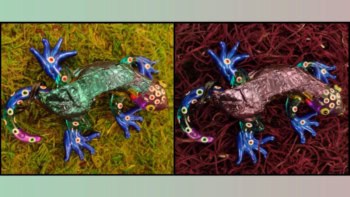
A novel hyperspectral and polarimetric optical sensor that’s small enough to fit on a smartphone has been developed by researchers in the US and Korea. The device consists of an alternating stack of polarization-sensitive organic photovoltaics (P-OPVs) and folded polymer retarders, and can detect four spectral and three polarization channels. However, the researchers claim that the design could ultimately sense 15 spectral channels over the visible spectrum.
Hyperspectral and polarization imaging has the potential to revolutionize many fields, from biomedicine to astronomy. Hyperspectral imaging allows visible light to be sensed in more narrow bands than are visible to the human eye. This can be useful, for example, for determining the chemical composition of objects, identifying hazardous gases, or detecting subtle differences in tissue composition for medical diagnosis. Polarimetry, on the other hand, measures polarization in light, providing useful information on surface geometry and subsurface detail of objects.
Current devices for measuring spectral and polarimetric information simultaneously, known as spectral polarization imaging, are large and expensive, and have image quality issues. To build a smaller, more user-friendly sensor, Ali Altaqui of North Carolina State University and his colleagues turned to the mantis shrimp.
Mantis shrimp can detect 12 different spectral channels, or colours, a huge step up from the three – red, green and blue – that humans can see. They can also analyse the polarization of light. These marine crustaceans use this advanced vision as a tool for navigation, communication, object separation and predator evasion.
The compound eye of mantis shrimp contains 12 spectrally selective photoreceptors – with sensitivity ranging from ultraviolet to far-red – and four elements that are sensitive to circular polarization, vertically stacked along a single optical axis. As light propagates into the stack, the mantis shrimp extracts spectral and polarization information.
Taking inspiration from these crustaceans, Altaqui and his colleagues’ sensor is comprised of spectrally selective elements, the folded polymer retarders, and P-OPVs vertically stacked along a single optical axis.
The device simultaneously detects spectral and polarization information in a similar way to the mantis shrimp’s eye. The first two P-OPVs detect the light’s polarization state; then an alternating arrangement of folded retarders and P-OPVs provides the spectral analysis.
Altaqui tells Physics World that when broadband light enters the device it is vertically polarized, by a polarizer. Then the first folded retarder rotates red light by 90°, polarizing it horizontally while leaving the other colours polarized vertically. Next, the light hits a P-OPV element. As this is polarized vertically, it absorbs the red light, while transmitting all other wavelengths.
The next folded retarder only rotates yellow light by 90°. And the following P-OPV element absorbs this yellow light, while transmitting the other colours. “This process is repeated where different folded retarders will rotate different colours by 90 degrees, allowing different P-OPVs to absorb the rotated colours,” Altaqui explains.
Pratik Sen, a co-author of the paper, published in Science Advances, says: “Organic semiconductors are interesting materials because they are semi-transparent and can be fabricated to induce intrinsic sensitivity to polarized light. This means we can integrate them into new and exciting device architectures that would not be possible with some of the more traditional semiconductor materials like silicon.”
Altaqui says that the sensor could have a wide range of applications, including in fields such as biomedical imaging, agriculture and food safety, defence, astronomy, atmospheric monitoring and machine vision. For example, it could be used for the early diagnosis of skin cancer, to assess the quality of crops or to characterize aerosols for climate modelling, he explains.
According to the researchers, modelling shows that their technique could be used to create detectors that measure more than 15 spectral channels with wavelengths from 400 to 750 nm. But Altaqui notes that they do not currently have the required retarder materials to produce 15 spectral bands. They are now working to further shrink the sensor and incorporate additional mantis shrimp eye features.



